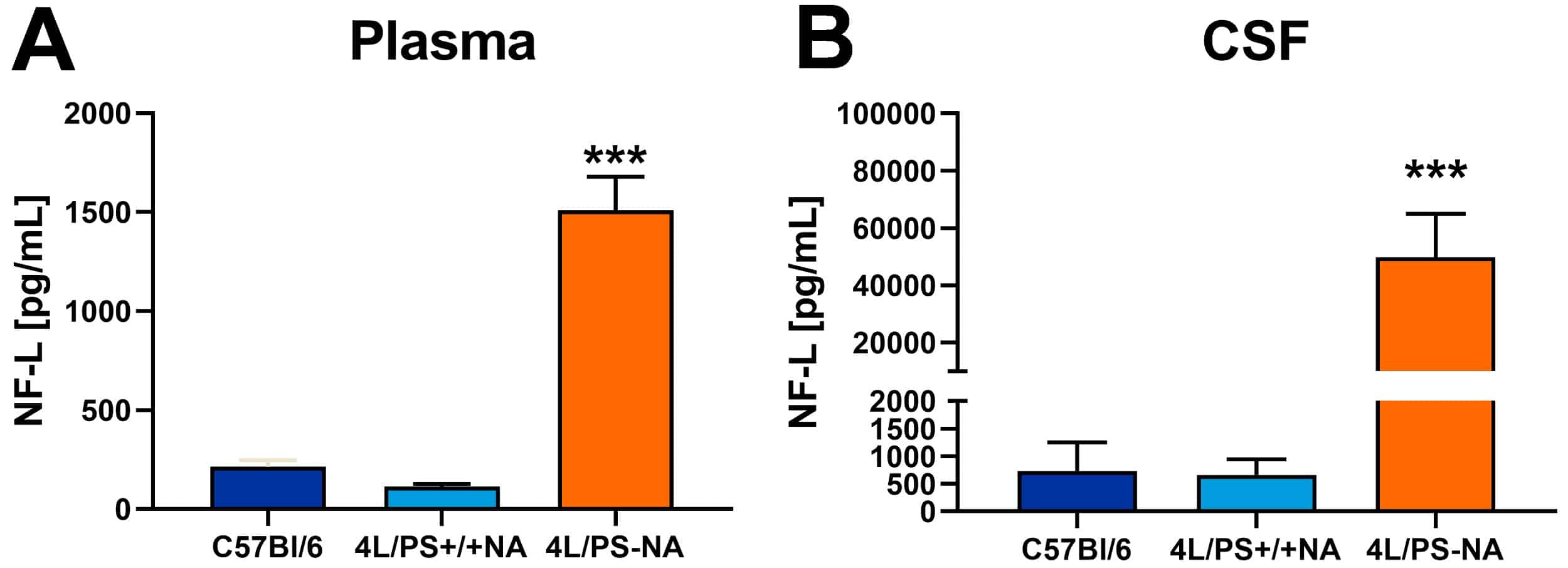4L/PS-NA mice express low levels of prosaposin and saposins, as well as β-glucosidase (GCase) with a point mutation at position V394L/V394L and model Gaucher disease, the most common lysosomal storage disease. The neuronal disease variant is characterized by aggregated protein accumulations in the brain and associated neurological manifestations.
The most important characteristics of 4L/PS-NA mice are:
- Strongly enlarged leukocytes and macrophages in visceral organs
- Muscle weakness and motor deficits
- Neuroinflammation
- Increased glucosylceramide and glucosylsphingosine levels in the brain
- Reduced survival
Glycosylceramide levels in the brain of 4L/PS-NA mice are already significantly increased at the age of 5 weeks compared to control (4L/PS+/+NA) mice. Levels further increase with age (Fig.1A). Evaluation of muscle strength in the wire suspension test shows a significantly reduced hanging time of 4L/PS-NA mice at the age of 18 weeks (Fig.1B).

Figure 1: Glucosylceramide accumulation and motor deficits 4L/PS-NA mice at the age of 5 to 18 weeks. A: GlcCer levels in the brain of 4L/PS-NA and control mice as well as C57Bl/6 mice at the age of 5, 12 and 18 weeks, n = 5; B: Time animals spent hanging in the wire suspension test at the age of 8, 12 and 18 weeks; n = 7. Mean + SEM. Two-way ANOVA with Bonferroni post hoc test. *p<0.05; **p<0.01. *differences between genotypes; #differences between age groups.
Neurofilament light chain levels as marker of neurodegeneration are highly increased in the plasma (Fig.2A) and the CSF (Fig.2B) of 4L/PS-NA mice at the age of 18 weeks compared to control (4L/PS+/+NA) and C57Bl/6 wild type mice.

Figure 2: Neurofilament light chain (NF-L) levels in the plasma and CSF of 4L/PS-NA mice. A: NF-L levels in the plasma and B: CSF of 4L/PS-NA mice at the age of 18 weeks; 4L/PS-NA: n = 7, 4L/PS+/+NA: n = 7, C57Bl/6: n = 7; One-way ANOVA with Tukey’s multiple comparison test. Significance compared to 4L/PS+/+NA littermates and C57Bl/6 mice; Mean + SEM. ***p<0.001.
QPS Neuropharmacology offers a custom-tailored study design for 4L/PS-NA mice and we are flexible to accommodate to your special interests. We are also happy to advise you and propose study designs. 4L/PS-NA mice show a relevant Gaucher disease phenotype already at young age. This grants a remarkable fast processing time of your Gaucher disease study. Furthermore, 4L/PS+/+NA littermates and C57Bl/6 mice are available as control animals needed for proper study design.
We are happy to evaluate the efficacy of your compound in the 4L/PS-NA mouse model! The most common readouts are:
- Survival
- Enlarged leukocytes and macrophages in several visceral organs
- Neuroinflammation
- Muscle strength and motor deficits
- Glucocerebrosidate (GCase) activity measurement
- Substrate measurements of Glucosylceramide and Glucosylsphingosin
You might be also interested in these related topics:
QPS Neuropharmacology is also ready to provide samples (brain tissue, CSF etc.) from 4L/PS-NA mice for analyses in your laboratory.
